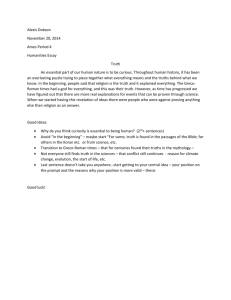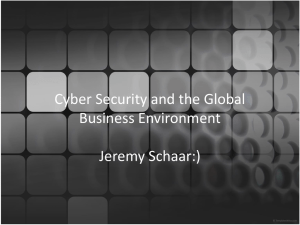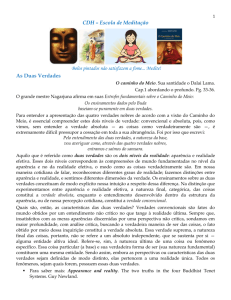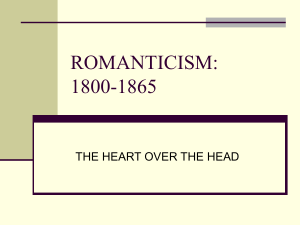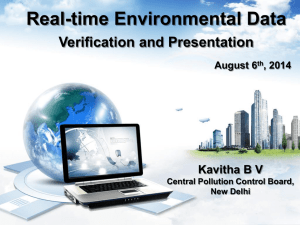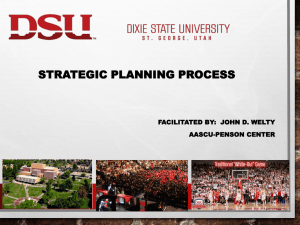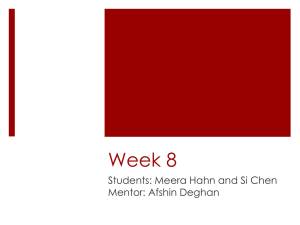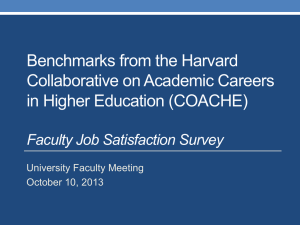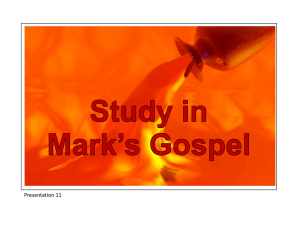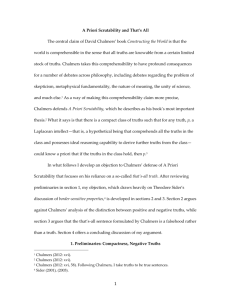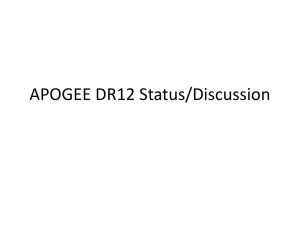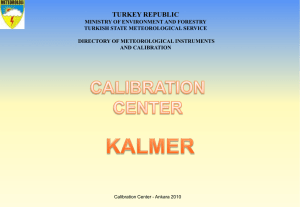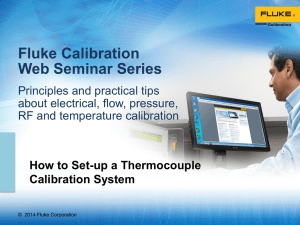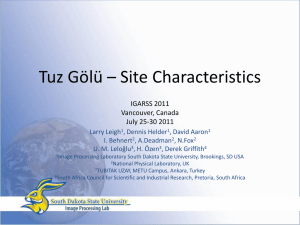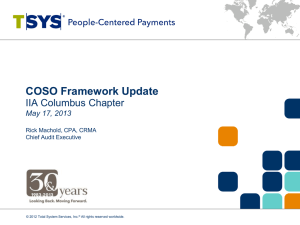establishing an observational climate benchmark data set
advertisement
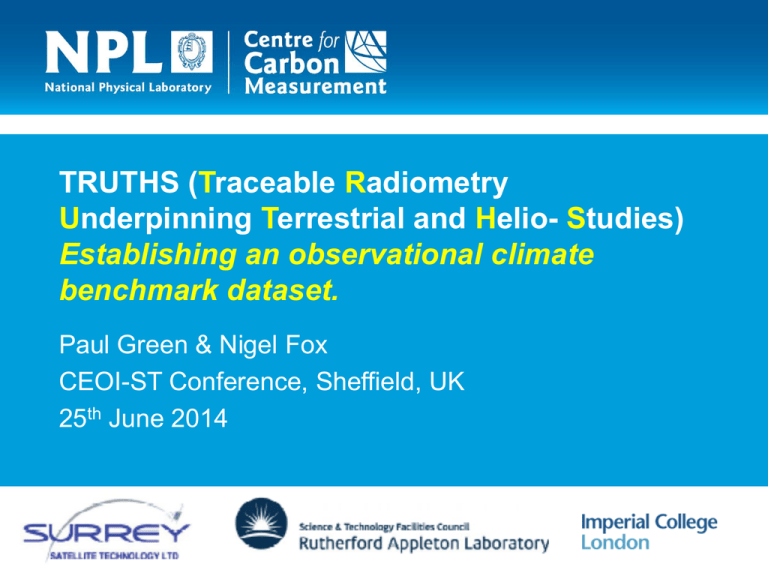
TRUTHS (Traceable Radiometry Underpinning Terrestrial and Helio- Studies) Establishing an observational climate benchmark dataset. Paul Green & Nigel Fox CEOI-ST Conference, Sheffield, UK 25th June 2014 Introduction Mission overview Science drivers • Climate benchmarking • Sensor inter-calibration • L2 data product applications • Draft MRD • New CEOI-funded study • Current situation & future developments What’s unique about TRUTHS? UK-led small satellite mission that will measure the solar irradiance and Earth solar-reflected radiance with high radiometric accuracy. Solar spectral irradiance (320* - 2300 nm) 0.3% (k=2) Total solar irradiance (0.2 - 30 μm integrated) 0.02% (k=2) Earth solar-reflected (320* - 2300 nm) 0.3% (k=2) Previous sensors have been limited to ~2-6% (k=2) due to limitation of on-board calibration & monitoring of degradation over mission lifetime. No traceability on-orbit. TRUTHS will include a flight-adapted version of the full pre-flight calibration chain on-board maintaining traceable high radiometric accuracy over the mission lifetime. Underpinning Science Drivers The establishment of ‘benchmark’ observational climate data of sufficient accuracy to allow unequivocal detection of climate change on decadal timescales. NASA (NRC/CLARREO), ESAC report, WMO-GSICS, GCOS, CEOS.. Provision of sensor “in-flight” SI traceability / use of a ‘reference’ sensor and its limiting constraints including means to link sensors for climate records CEOS (and individual space agencies) WMO-GSICS Various studies in progress Chinese activities to mimic TRUTHS concept Secondary L2 data usage has multiple applications, SMEs, CEMS etc. Studies in progress Climate benchmark driver Sound policymaking requires high confidence in climate (model) predictions. High confidence in model predictions is only achieved by verification against decadal-scale change observations with high, rigorously known accuracy. Our current observing capability is inadequate to confidently observe the small but critical climate change signals that are expected to occur over decadal time scales. Observational measurements are fundamental in assessing the accuracy of climate change projections made by models and for the attribution of climate change. An observational climate benchmark data set of sufficient accuracy to test model predictions is one of the key challenges laid down by the international climate science community. TRUTHS (Traceable Radiometry Underpinning Terrestrial- and HelioStudies) & the US-sister mission CLARREO (Climate Absolute Reflectance and Refractivity Observatory) are complementary mission concepts proposed to address this issue. Climate benchmarking What is a climate benchmark? A snap-shot of the global climate state, when repeated over time allows an observation-based measure of change. Needs high accuracy, anchored to a known reference standard – traceable to SI What do we need to measure? The incoming and outgoing energy that drives the climate in parameters that can be directly related to climate model predictions. 1. The incoming solar irradiance spectrum 2. The reflected solar radiance spectrum of the Earth Specifics Spectrally resolved to allow climate process attribution Moderate instantaneous res. spatially, zonally averaged with true global coverage representative of a typical year. Why high accuracy? High accuracy reduces time to detection TRUTHS or (CLARREO) (proposed satellites) accuracy (0.3% k=2) near optimum to the perfect observing system for 100% cloud feedback TRUTHS ~ 12 yrs CERES ~ 25 yrs MODIS ~ 40 yrs For 50% difference > 20 yrs CLARREO Mission Goal (Activity): Observational basis for policy Provide accurate, broadly acknowledged climate data records that can provide the foundation for informed decisions on mitigation and adaptation policies addressing the effects of climate change on society. Overall Science Goal: Measure and quantify climate change Make high accuracy, global, in-orbit SI-traceable decadal change observations sensitive to the most critical, but least understood, climate forcings, responses and feedbacks. Key Science Requirements: High absolute accuracy, spectral resolution and range 1. To measure the absolute spectrally resolved radiance in the infrared with high accuracy (0.1K 3σ brightness temperature) using nadir viewing spectrometers in Earth orbit. 2. To measure the absolute spectrally resolved nadir reflectance of solar radiation from Earth to space with high accuracy (0.3% 2σ). 3. To utilise Global Navigation Satellite Systems (GNSS) radio occultation as a source for another benchmark of the climate system. 4. To use CLARREO as a high accuracy calibration standard for use by operational, climate relevant infrared and reflected solar instruments (e.g. CrIS, IASI, MODIS, etc.) Sensor inter-calibration By crossing orbits of other satellites, viewing the same target (ocean, land, cloud top, instrumented vicarious calibration site, moon) TRUTHS would transfer high accuracy traceable radiometric calibration to other sensors. Upgrade performance Bridge gaps in climate data record Cost effective Studies are underway to determine the imager specification drivers (spectral (5 nm) & spatial resolution (50-100m), SNR …) to optimise this process & determine achievable accuracy transfer. CEOI 6th call study (2013) Reviewed the key science drivers & refine the mission technical specification. Demonstrated that current or planned sensors could not be ‘upgraded’ to meet the required specifications. Revised the implementation options, devising a low technical risk solution - reducing the number of mechanisms and identifying opportunities for a descoped ‘TRUTHS-light’ or ‘tech-demosat’ for early implementation. Produce a draft mission requirements document (MRD) for the full TRUTHS mission and the principle de-scoped option. Science developments Benchmarking Level Requirement Level 1 All-sky climate benchmark Spectral range: 320/400-2300 nm, resolution: 8-25 nm Accuracy: broadband 0.3%(k=2), spectral 0.3%-1%(k=2) for sampling: zonal average (30-60° longitude res.) Level 2 Clear-sky/cloudy & land/ocean climate benchmark As level 1 but with higher instantaneous accuracy (reduced averaging) and smaller spatial sampling (≤250m). Improved spectral accuracy in some bands, e.g. 0.5%(k=2) in 600700 nm spectral region. Level 3 Improved cloud-type determination climate benchmark & on-orbit reference calibration sensor. As level 2 but with higher instantaneous accuracy (reduced averaging) improved spatial resolution & platform pointing. Platform developments Parameter Value Orbit 609 circular orbit at 90° inclination Total Instrument Mass 100 kg Maximum Power Requirement 185 W (low) 320W (high) Instrument Size < 1x0.75x0.75 m Pointing accuracy 1 km on ground Pointing knowledge ~200 m Slew capability ~ 2 deg/s (TBC) Lifetime 3 yrs minimum ideally 5 yrs plus Data generated per day ~ 1.5 TByte Imager developments Initial SNR estimate for a prism-based earth imager design with three bands UV-VIS(320-450 nm), VIS-NIR (450-1000 nm) & SWIR (1000-2300 nm). New CEOI-funded study New UKSA CEOI-funded study with NPL & SSTL to: • Further progress MRD results to trade-off science requirements vs technical complexity/cost including benefits of non-benchmark goals. • More detailed design of key technologies (Imager) • Develop the in-flight calibration method • Provide robust quantitative evidence on TRUTHS ability to improve performance of other sensors. • Breakdown of modular ROM cost Summary 2013 & current 7th call CEOI-funded studies have/will significantly evolved the TRUTHS mission concept, resulting in draft MRD & leveraging further studies. Compelling arguments resulted in Chinese ‘TRUTHS’ project now underway. Interest from Belgians, Swiss & US (CLARREO) to partner. TRUTHS on BIS Long-Term Capital Investment in Science & Research plan consultancy. Opportunity as free-flyer or on ISS (70-80% science). Phase 0/A study funding clear next step. Further information: http://www.npl.co.uk/TRUTHS paul.green@npl.co.uk nigel.fox@npl.co.uk
